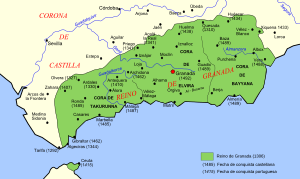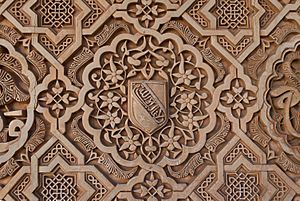Fatima bint al-Ahmar facts for kids
Quick facts for kids Fatima bint al-Ahmar |
|
|---|---|
| Born | 1260 or 1261 |
| Died | 26 February 1349 (aged 88–89) |
| Burial | Royal Cemetery, The Alhambra |
| Spouse | Abu Said Faraj |
| Issue | Ismail I |
| House | Nasrid dynasty |
| Father | Muhammad II |
| Mother | Nuzha |
| Religion | Islam |
Fatima bint Muhammad bint al-Ahmar (Arabic: فاطمة بنت الأحمر) (born around 1260 – died February 26, 1349) was a Nasrid princess. She lived in the Emirate of Granada, which was the last Muslim kingdom in Spain. Fatima was the daughter of Sultan Muhammad II. She was also an expert in barnamaj, which are special books about Islamic scholars.
Fatima married her father's cousin, Abu Said Faraj. Their son, Ismail I, later became sultan. He took the throne from her half-brother, Nasr. Fatima played a big role in her son's government. She was even more active when her grandsons, Muhammad IV and Yusuf I, became sultans. Both of them were very young when they started ruling. Fatima helped guide them. A historian named Ibn al-Khatib wrote that she was "surpassing the women of her time." Historians today believe her wisdom helped the Nasrid family survive and succeed.
Contents
The Emirate of Granada
The Emirate of Granada was the last Muslim state in Spain. Fatima's grandfather, Muhammad I, founded it in the 1230s. The Nasrid dynasty ruled this kingdom.
Granada managed to stay independent for a long time. It was surrounded by two powerful neighbors. To the north was the Christian Crown of Castile. To the south was the Muslim Marinid Sultanate in Morocco. Granada often made alliances or fought with these powers. Sometimes, it even encouraged them to fight each other. This helped Granada avoid being taken over.
Most historical records do not show women openly involved in Granada's politics. However, women sometimes took part behind the scenes. Sultans often died young or were assassinated. Sometimes, very young sultans came to power. In these cases, royal women often looked after their families' interests. They also protected their children's rights to the throne. They even helped with diplomacy with other kingdoms.
Fatima's Life
Early Years
Fatima was born in 1260 or 1261. This was during the rule of her grandfather, Muhammad I. Her father, Muhammad II, was next in line for the throne. Her mother was Nuzha.
Fatima had an older brother, Muhammad III. She also had a half-brother, Nasr. Her father, Muhammad II, was very learned. He was known as al-Faqih, meaning an Islamic scholar. He encouraged his children to learn. Fatima became an expert in barnamaj. These were special lists and stories about Islamic scholars. Her brothers studied poetry and astronomy. Fatima likely received her education at the royal palace, the Alhambra.
Marriage and Family
Fatima's father, Muhammad II, became sultan in 1273. He arranged for Fatima to marry Abu Said Faraj ibn Ismail. Abu Said was a cousin and an important advisor. He was also the governor of Málaga. Fatima and Abu Said had their first child, Ismail, in 1279.
Fatima later moved to Málaga with her husband. There, she raised her children and continued her studies. She had another son named Muhammad. This son later had four sons of his own. These grandsons eventually moved to North Africa.
Political Influence
When her brother, Muhammad III, became sultan in 1302, Fatima had a good relationship with him. Her husband remained governor of Málaga. However, Muhammad III was removed from power in 1309. Her half-brother, Nasr, took the throne. Fatima and her husband did not get along well with Nasr.
As Nasr's rule became unpopular, Fatima joined groups trying to overthrow him. Her husband, Abu Said, led a rebellion in 1311. They wanted to make their son, Ismail, the new sultan. Ismail was seen as having a stronger claim to the throne. Their forces defeated Nasr's army. But Nasr managed to escape to Granada. Abu Said then tried to take the capital city. However, he did not have enough supplies for a long fight.
Abu Said later made a deal with the Marinid dynasty. He planned to give Málaga to them. When the people of Málaga found out, they felt betrayed. They removed Abu Said from power. Instead, they supported Ismail. Ismail then imprisoned his father. Abu Said died in prison in 1320.
With her son Ismail in control of Málaga, Fatima helped him plan another rebellion against Nasr. Ismail's army grew as he marched towards Granada. The people of the capital opened the city gates for him. Nasr agreed to step down. Ismail became sultan in February 1314. Fatima became the queen mother at court. Even though her son and husband had problems, Fatima and Ismail remained close. She helped him with political matters. When Ismail was badly hurt in 1325, he was brought to her palace. He died there from his injuries.
"The Sultan's Grandmother"
After Ismail's death, Fatima was a very important person at court. She helped her grandson, Muhammad IV, become sultan. Muhammad was only ten years old. Fatima and a guardian named Abu Nuaym Ridwan became his tutors and advisors. They played a big part in the government.
During this time, people called Fatima jaddat al-sultan, meaning "The Sultan's Grandmother." This was when she was most active in politics. A vizier (a high-ranking official) named Ibn al-Mahruq was killed in 1328. This happened while he was at Fatima's palace, discussing state affairs. Some historians think she might have been involved in this event.
Muhammad IV was killed in 1333. His 15-year-old brother, Yusuf I, took his place. Fatima again became a tutor and advisor for her grandson. Yusuf I was still considered young. His power was limited. Fatima died on February 26, 1349. She was over 90 years old by the Islamic calendar. She was buried in the royal cemetery at the Alhambra.
Legacy
The famous poet and historian Ibn al-Khatib wrote a special poem for Fatima's death. It was the only poem ever written for a Nasrid princess. In it, he said she was unique. He praised her as "the great pearl at the center of the dynasty's necklace." He also called her "the protector of the kings."
After Fatima's death, Yusuf I continued to rule Granada. His son, Muhammad V, followed him. Under their leadership, Granada reached its peak. Historians believe Fatima's "vision and constancy" helped the dynasty survive. This was especially true during the difficult reigns of her brothers, son, and grandsons. These times were often filled with assassinations and young rulers.
Thanks to Fatima's family line, her son Ismail and his descendants gained power. This was important because they were not direct male descendants of Muhammad I. Ismail becoming sultan was the first time the throne passed through the mother's side of the family. This happened again later with Yusuf IV. Fatima's descendants started a new branch of the Nasrid dynasty. Historians compare her role to María de Molina. María de Molina was a queen who also guided her young son and grandson who became kings in Spain.
In fiction
Fatima bint al-Ahmar is the main character in the Sultana series of historical novels by Lisa Yarde.
Family tree
| Family tree of Fatima bint al-Ahmar | ||||||||||||||||||||||||||||||||||||||||||||||||||||||||||||||||||||||||||||||||||||||||||||||||||||||||||||||||||||||||||||||||||||||||||||||||||||||||||||||||||||||||||||||||||||||||||||||||||||||||||||||||||||||||||||||||||||||||||||||||||||||||||||||||||||||||||||||||||||||||||||||||||||||||||||||||||||||||||||||||||||||||||||||||||||||||||||||||||||||||||||||||||||||||||||||||||||||||||||||||||||||||||||||||||||||||||||||||||||||||||||||||
|---|---|---|---|---|---|---|---|---|---|---|---|---|---|---|---|---|---|---|---|---|---|---|---|---|---|---|---|---|---|---|---|---|---|---|---|---|---|---|---|---|---|---|---|---|---|---|---|---|---|---|---|---|---|---|---|---|---|---|---|---|---|---|---|---|---|---|---|---|---|---|---|---|---|---|---|---|---|---|---|---|---|---|---|---|---|---|---|---|---|---|---|---|---|---|---|---|---|---|---|---|---|---|---|---|---|---|---|---|---|---|---|---|---|---|---|---|---|---|---|---|---|---|---|---|---|---|---|---|---|---|---|---|---|---|---|---|---|---|---|---|---|---|---|---|---|---|---|---|---|---|---|---|---|---|---|---|---|---|---|---|---|---|---|---|---|---|---|---|---|---|---|---|---|---|---|---|---|---|---|---|---|---|---|---|---|---|---|---|---|---|---|---|---|---|---|---|---|---|---|---|---|---|---|---|---|---|---|---|---|---|---|---|---|---|---|---|---|---|---|---|---|---|---|---|---|---|---|---|---|---|---|---|---|---|---|---|---|---|---|---|---|---|---|---|---|---|---|---|---|---|---|---|---|---|---|---|---|---|---|---|---|---|---|---|---|---|---|---|---|---|---|---|---|---|---|---|---|---|---|---|---|---|---|---|---|---|---|---|---|---|---|---|---|---|---|---|---|---|---|---|---|---|---|---|---|---|---|---|---|---|---|---|---|---|---|---|---|---|---|---|---|---|---|---|---|---|---|---|---|---|---|---|---|---|---|---|---|---|---|---|---|---|---|---|---|---|---|---|---|---|---|---|---|---|---|---|---|---|---|---|---|---|---|---|---|---|---|---|---|---|---|---|---|---|---|---|---|---|---|---|---|---|---|---|---|---|---|---|---|---|---|---|---|---|---|---|---|---|---|---|---|---|---|---|---|---|---|---|---|---|---|---|---|---|---|---|---|---|---|---|---|---|---|---|---|---|---|---|---|---|---|---|---|---|---|---|---|---|---|---|---|---|---|---|---|---|---|---|
Note: This family tree is not complete. It only shows sultans and other important family members. |
||||||||||||||||||||||||||||||||||||||||||||||||||||||||||||||||||||||||||||||||||||||||||||||||||||||||||||||||||||||||||||||||||||||||||||||||||||||||||||||||||||||||||||||||||||||||||||||||||||||||||||||||||||||||||||||||||||||||||||||||||||||||||||||||||||||||||||||||||||||||||||||||||||||||||||||||||||||||||||||||||||||||||||||||||||||||||||||||||||||||||||||||||||||||||||||||||||||||||||||||||||||||||||||||||||||||||||||||||||||||||||||||
See also
 In Spanish: Fátima Bint Al-Ahmar para niños
In Spanish: Fátima Bint Al-Ahmar para niños



